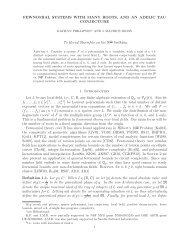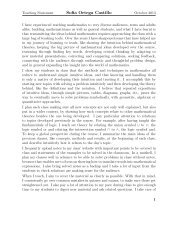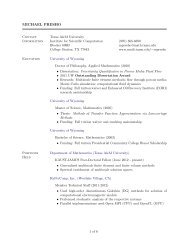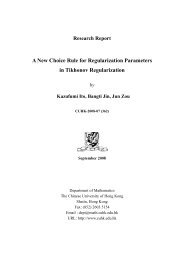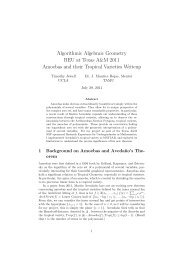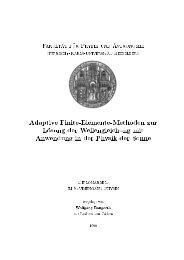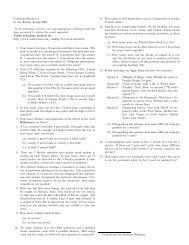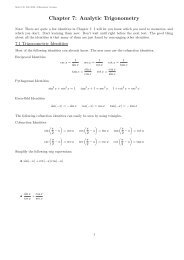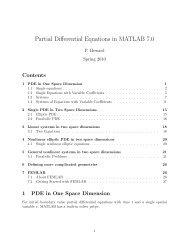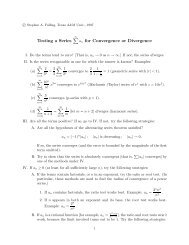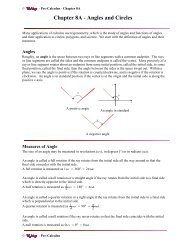Pythagoras and the Pythagoreans - Department of Mathematics
Pythagoras and the Pythagoreans - Department of Mathematics
Pythagoras and the Pythagoreans - Department of Mathematics
You also want an ePaper? Increase the reach of your titles
YUMPU automatically turns print PDFs into web optimized ePapers that Google loves.
<strong>Pythagoras</strong> <strong>and</strong> <strong>the</strong> <strong>Pythagoreans</strong> 27<br />
6.4 More Pythagorean Geometry<br />
Contributions 22 by <strong>the</strong> <strong>Pythagoreans</strong> include<br />
• Various <strong>the</strong>orems about triangles, parallel lines, polygons, circles,<br />
spheres <strong>and</strong> regular polyhedra. In fact, <strong>the</strong> sentence in Proclus<br />
about <strong>the</strong> discovery <strong>of</strong> <strong>the</strong> irrationals also attributes to <strong>Pythagoras</strong><br />
<strong>the</strong> discovery <strong>of</strong> <strong>the</strong> five regular solids (called <strong>the</strong>n <strong>the</strong> ‘cosmic<br />
figures’). These solids, <strong>the</strong> tetrahedron (4 sides, triangles), cube (6<br />
sides, squares, octahedron (8 sides, triangles), dodecahedron (12<br />
sides, pentagons), <strong>and</strong> icosahedron (20 sides, hexagons) were possibly<br />
known to <strong>Pythagoras</strong>, but it is unlikely he or <strong>the</strong> <strong>Pythagoreans</strong><br />
could give rigorous constructions <strong>of</strong> <strong>the</strong>m. The first four were associated<br />
with <strong>the</strong> four elements, earth, fire, air, <strong>and</strong> water, <strong>and</strong><br />
because <strong>of</strong> this <strong>the</strong>y may not have been aware <strong>of</strong> <strong>the</strong> icosahedron.<br />
Usually, <strong>the</strong> name Theaetetus is associated with <strong>the</strong>m as <strong>the</strong> ma<strong>the</strong>matician<br />
who proved <strong>the</strong>re are only five, <strong>and</strong> moreover, who gave<br />
rigorous constructions.<br />
Tetrahedron Cube Octahedron<br />
Dodecahedron Icosahedron<br />
• Work on a class <strong>of</strong> problems in <strong>the</strong> applications <strong>of</strong> areas. (e.g. to<br />
construct a polygon <strong>of</strong> given area <strong>and</strong> similar to ano<strong>the</strong>r polygon.)<br />
• The geometric solutions <strong>of</strong> quadratics. For example, given a line<br />
segment, construct on part <strong>of</strong> it or on <strong>the</strong> line segment extended a<br />
parallelogram equal to a given rectilinear figure in area <strong>and</strong> falling<br />
22 These facts generally assume a knowledge <strong>of</strong> <strong>the</strong> Pythagorean Theorem, as we know it.<br />
The level <strong>of</strong> rigor has not yet achieved what it would become by <strong>the</strong> time <strong>of</strong> Euclid



